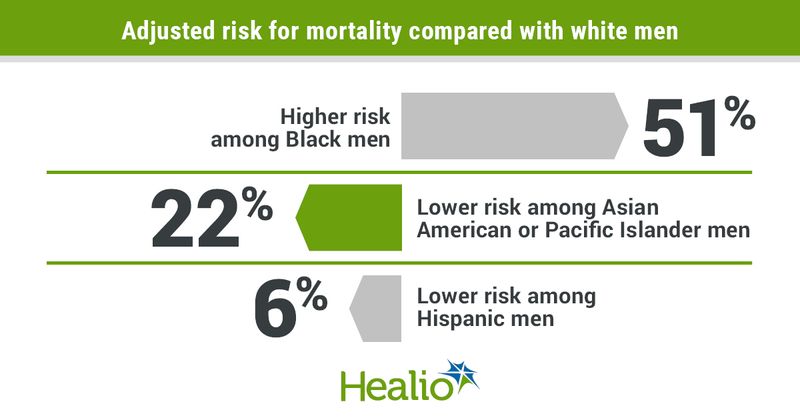Socioeconomic, insurance status linked to racial disparities in prostate cancer mortality
Socioeconomic and insurance status appeared associated with increased mortality after prostate cancer surgery among Black men, who were twice as likely as white men to die of the disease, according to study results published in Cancer.
“If Black men had the same socioeconomic status and insurance status as white men, the survival difference between Blacks and whites would be narrowed from 51% to 30%,” Wanqing Wen, MD, MPH, researcher in the department of medicine at Vanderbilt University Medical Center, told Healio. “On the other hand, we found that Hispanics had better OS than whites despite their lower socioeconomic status and less-than-optimal insurance coverage. If Hispanics had the same education levels, median household income and insurance status as whites, the survival difference between Hispanics and whites would be enlarged from 6% to 12%.”

Little is known about the factors associated with racial disparities in prostate cancer outcomes, and few studies have examined the differences between white men and Hispanic men or white men and Asian American or Pacific Islander men, according to the researchers.
Wen and colleagues used the National Cancer Database to identify 526,690 men with prostate cancer who underwent radical prostatectomy between 2004 and 2014.
The analysis included 432,640 (82.1%) white men, 63,602 (12.1%) Black men, 21,458 (4.1%) Hispanic men, and 8,990 (1.7%) Asian American or Pacific Islander men.
The researchers used multivariable Cox proportional hazards models to measure racial survival disparities and inverse probability weighting to adjust for imbalances of prognostic factors.
OS, defined as the number of months from the date of radical prostatectomy to the date of death, served as the primary outcome.
Median follow-up was 5.5 years (interquartile range, 3.2-8).
Results showed 5-year OS rates of 96.8% among Asian American or Pacific Islander men, 96.5% among Hispanic men, 96.2% among white men and 94.9% among Black men.
After adjusting for age and year of prostate cancer diagnosis, researchers found that compared with white men, Black men had 51% higher risk for mortality (HR = 1.51; 95% CI, 1.47-1.56), Asian American or Pacific Islander men had 22% lower risk for mortality (HR = 0.78; 95% CI, 0.71-0.86) and Hispanic men had 6% lower risk for mortality (HR = 0.94; 95% CI, 0.88-1).
When the researchers adjusted for all clinical and nonclinical factors, the OS disparity narrowed to 20% higher for Black vs. white men. Conversely, the disparity between Asian American and Pacific Islander men and white men increased to 35%.
Education, median household income and insurance status contributed most to the racial disparity, according to the researchers.
“With adjustments for multiple factors, Black men continue to have 20% higher mortality and Asian Americans and Pacific Islanders have 35% lower mortality compared with whites,” Wen said. “Therefore, other health-related factors such as genetic and lifestyle factors (smoking, drinking, obesity and physical inactivity) that were not evaluated in this study should be investigated for their contribution to the racial survival disparity.”
The study could not analyze the cause-specific mortality due to the lack of information, according to Wen.
“Therefore, future studies with cause-specific mortality are warranted to further investigate racial disparity in cancer-specific survival of [men with prostate cancer],” he said.
For more information:
Wanqing Wen, MD, MPH, can be reached at Vanderbilt University Medical Center, 1161 21st Ave. South, Nashville, TN 37232; email: wanqing.wen@vumc.org.

